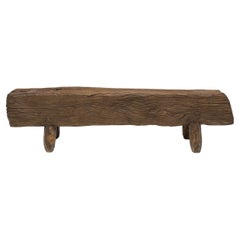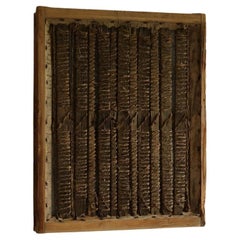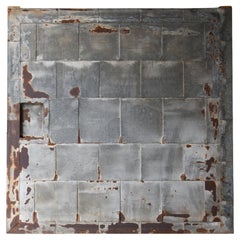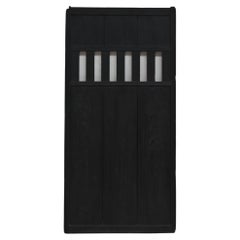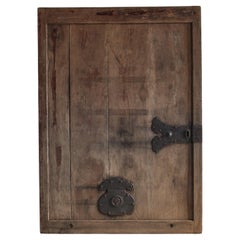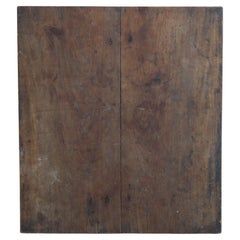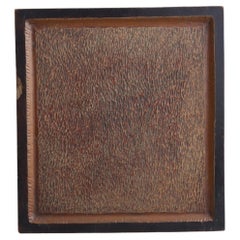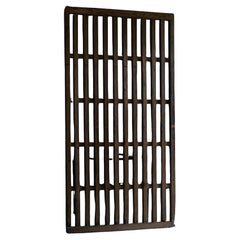Wabi Sabi Door
to
5
10
3
73
64
23
16
6
4
4
3
1
1
1
1
1
1
1
3
1
Sort By
Wabi Sabi Door Bench
Located in Chicago, IL
embodies the spirit of wabi-sabi, the Japanese philosophy that beauty and integrity can be found within the
Category
21st Century and Contemporary Chinese Organic Modern Benches
Materials
Reclaimed Wood
Japanese Antique Door, Abstract Art Wabi Sabi, 1860s-1900s
Located in Katori-Shi, 12
the world of wabi and sabi.
Recommended as a wall painting.
It was made in the Meiji period (1860s
Category
Early 20th Century Meiji Doors and Gates
Materials
Wood
Japanese Antique Huge Galvanized Steel-Clad Door 1920s-1940s / Wabi Sabi
Located in Chōsei District Nagara, JP
piece that possesses the depth of old materials and the spirit of wabi-sabi.
Weight: approx. 30 kg
Category
Vintage 1910s Japanese Showa Doors and Gates
Materials
Tin
$4,500
H 70.08 in W 69.69 in D 1.58 in
Huge Wabi Sabi Early 19th Japanese Charred Cedar Door Wall Art
Located in London, GB
A huge early 19th century Edo period Japanese door in charred cedar.
Sliding panel in place to
Category
Antique Mid-19th Century Japanese Edo Doors and Gates
Materials
Cedar
XXL Late Edo Period Japanese Cedar “Kura” Door/Wall Hanging Wabi Sabi
Located in London, GB
A huge early 19th C. Japanese Kura door in cedar.
Beautifully patinated bleached-out wood with
Category
Antique Early 19th Century Japanese Edo Doors and Gates
Materials
Iron
$6,070
H 74.02 in W 53.15 in D 2.27 in
Japanese Antique Iron Plate Door 1860s-1900s / Low Table Sofa Table Wabi Sabi
Located in Chōsei District Nagara, JP
essence and vintage flavor to a space.
The spirit of “wabi-sabi” resides in this piece.
Tranquility, age
Category
Early 20th Century Japanese Meiji Doors and Gates
Materials
Iron
$3,000
H 75.6 in W 47.84 in D 2.37 in
Japanese Antique Wooden Board , Wall Decoration Abstract Art , Wabi-Sabi
Located in Katori-Shi, 12
a masterpiece that allows you to fully experience the world of wabi-sabi.
If you display it as a
Category
Early 20th Century Japanese Taisho Doors and Gates
Materials
Wood
$800
H 29.14 in W 25.99 in D 2.17 in
Japanese Antique Wood Carving Wall Panel, Abstract Art , Wabi Sabi
Located in Katori-Shi, 12
This wall-hanging carved wooden ornament is made from recycled zelkova wood from a kotatsu table from the Meiji period.
The beautiful grain of the wood has been carefully carved by ...
Category
Early 20th Century Japanese Meiji Doors and Gates
Materials
Wood
$950
H 25.2 in W 23.23 in D 1.58 in
19th thick black lattice door. antique sliding door. wabi sabi Japanese shoji
Located in 常陸大宮市, JP
Japanese antique thick lattice sliding door, ara-koshido.
Edo to Meiji period circa 1870s to early
Category
Antique Late 19th Century Japanese Edo Furniture
Materials
Wood
$600 Sale Price
20% Off
H 68.7 in W 35.83 in D 1.38 in
wabi sabi Yoshino Japanese cedar door rustic garden exterior door 1870s-1920s
Located in 常陸大宮市, JP
.
Made of well-aged Yoshino Cedar solid wood board, using the part with dynamic grains, as a wabi sabi
Category
Antique Late 19th Century Japanese Rustic Furniture
Materials
Wood, Cedar
$1,400
H 67.13 in W 33.27 in D 1.78 in
Japanese Antique Bamboo Door / Wall Decoration / 1868-1912s / Wabi-Sabi
Located in Iwate-gun Shizukuishi-cho, Iwate Prefecture
This is a wall decoration using an old Japanese door.
It is thought to date from the Edo to Meiji
Category
Antique Late 19th Century Japanese Meiji Decorative Art
Materials
Iron
$3,000
H 68.71 in W 56.11 in D 2.25 in
Japanese Antique Bamboo Door / Wall Decoration / 1868-1912s / Wabi-Sabi
Located in Iwate-gun Shizukuishi-cho, Iwate Prefecture
This is a wall decoration using an old Japanese door.
It is thought to date from the Edo to Meiji
Category
Antique Mid-19th Century Japanese Edo Decorative Art
Materials
Iron
$3,000
H 73.23 in W 41.34 in D 2.56 in
Japanese Antique Glass door storage shelf Cupboard Wabi-Sabi Japandi
Located in Chiba, Chiba
This is a Japanese storage cabinet with glass doors, originally used many years ago as a
Category
Early 20th Century Japanese Furniture
Materials
Wood
$2,500
H 68 in W 19.18 in D 34.85 in
Japanese antique cabinet with wooden lattice doors, Wabi Sabi, Japandi
Located in Katori-Shi, 12
wood. The sliding door is decorated with delicate frosted glass and wooden latticework, making it both
Category
Early 20th Century Japanese Meiji Antiquities
Materials
Wood
$3,500
H 21.66 in W 37.21 in D 11.42 in
19th thick lattice door, antique sliding door w/ panel. Japanese wabi sabi shoji
Located in 常陸大宮市, JP
Japanese antique thick lattice sliding door, ara-koshido,
Edo to Meiji period circa 1870s to early
Category
Antique Late 19th Century Japanese Edo Furniture
Materials
Wood
$682 Sale Price
25% Off
H 69.61 in W 33.86 in D 1.26 in
Bar Wabi Sabi Multi-Color Glass Doors by Orfeo Quagliata
By Orfeo Quagliata
Located in Naucalpan, Edo de Mex
furniture object which doors are made 100% of high quality fused glass, created with the exclusive Barcode
Category
2010s Mexican Buffets
Materials
Wood, Glass
$11,310 / item
H 45.28 in W 35.63 in D 15.95 in
Japanese Antique Door "Wall Decoration" 1860s-1900s / Abstract Art Wabi Sabi
Located in Sammu-shi, Chiba
that evokes the sensibility of the Wabi-Sabi period.
Category
Early 20th Century Japanese Meiji Decorative Art
Materials
Bamboo, Cedar
$600
H 25.99 in W 17.33 in D 1.97 in
Chinese Wabi Sabi Farm Table
Located in Chicago, IL
plenty of wabi-sabi appeal. An antique farm door comprises the expansive top, minimally worked to
Category
21st Century and Contemporary Chinese Organic Modern Dining Room Tables
Materials
Reclaimed Wood
Japanese Antique Large Tansu, Panel Doors, Meiji Era 1868-1912, Wabi Sabi
Located in Hitachiomiya-shi, 08
doors and dark, timeworn finish reflect the quiet beauty of wabi-sabi. The surface was originally
Category
Antique Mid-19th Century Japanese Meiji Cabinets
Materials
Cedar
$3,700
H 30.63 in W 66.78 in D 24.57 in
Japanese Antique Cabinet with Glass Doors, Taisho Era (1912–1926), Wabi-Sabi
Located in Hitachiomiya-shi, 08
lacquer. Gentle, timeworn areas of lacquer wear create a rich wabi-sabi patina.
Behind the glass are
Category
Early 20th Century Japanese Taisho Cabinets
Materials
Wood, Cherry, Cedar
$2,000
H 47.52 in W 36.62 in D 14.97 in
Japanese Antique Cabinet with Glass Doors, Taisho Era (1912–1926), Wabi Sabi
Located in Hitachiomiya-shi, 08
piece features a warm and inviting texture that has deepened over time, adding to its wabi-sabi charm
Category
Early 20th Century Japanese Taisho Cabinets
Materials
Cedar
$1,600
H 34.06 in W 38.19 in D 14.89 in
Japanese Antique Small Door Wall Decoration 1860s-1900s / Abstract Art Wabi Sabi
Located in Chōsei District Nagara, JP
randomly created expressions and the weathering of the materials evoke the spirit of “wabi-sabi,” an
Category
Early 20th Century Japanese Meiji Decorative Art
Materials
Bamboo, Cedar
$700
H 25.99 in W 21.66 in D 1.58 in
Japanese Antique Small Cabinet with Wooden Door, Taisho Era'1912-1926'Wabi Sabi
Located in Hitachiomiya-shi, 08
tells over time.
Cleaned and disinfected with non-toxic solution.
The doors and drawers moves smoothly
Category
Early 20th Century Japanese Taisho Cabinets
Materials
Wood
$1,200
H 26.11 in W 23.51 in D 15.28 in
Japanese Antique Large Mizuya Tansu, Meiji Era '1868–1912', Wabi Sabi
Located in Hitachiomiya-shi, 08
beautiful patina that evokes the spirit of wabi-sabi. The front features sliding doors with vertical slats
Category
Antique Mid-19th Century Japanese Meiji Cabinets
Materials
Cedar
$4,000
H 34.73 in W 66.78 in D 24.57 in
Japanese Antique Three-Section Cupboard, Late Meiji (1890s–1912)
Located in Hitachiomiya-shi, 08
mellows with age, giving the surface calm depth in the spirit of wabi-sabi.
Behind the glass sliding
Category
Early 20th Century Japanese Meiji Cupboards
Materials
Cedar
$3,500
H 68.67 in W 34.53 in D 13.67 in
Japanese Antique Door, Abstract Art Wabi Sabi, 1860s-1900s
Located in Katori-Shi, 12
the world of wabi and sabi.
Recommended as a wall painting.
It was made in the Meiji period
Category
Early 20th Century Meiji Doors and Gates
Materials
Wood
Japanese Antique Door 1800s-1860s/Architecture Wabi-Sabi Gates
Located in Sammu-shi, Chiba
a wabi-sabi world.
It weighs about 35 kg.
Category
Antique Late 19th Century Japanese Edo Doors and Gates
Materials
Steel
Japanese Antique Door 1800s-1860s / Wall Decoration Wabi Sabi
Located in Sammu-shi, Chiba
It is a very old, Japanese iron-plated door.
This door is from the Edo period (1800s-1860s).
It has
Category
Antique Late 19th Century Japanese Edo Doors and Gates
Materials
Iron
Japanese Antique Huge Door 1800s-1860s/Architecture Wabi-Sabi Gates
Located in Sammu-shi, Chiba
.
It is truly a wabi-sabi world.
It weighs about 50 kg.
Category
Antique Late 19th Century Japanese Edo Doors and Gates
Materials
Steel
$4,500
H 2.37 in W 48.04 in L 2.37 in
Japanese Antique Oil Paper Pasting Door / Wall Decoration / Wabi-Sabi
Located in Iwate-gun Shizukuishi-cho, Iwate Prefecture
[This item is exclusively for doors without black patterns]
This is an original one we made by
Category
20th Century Japanese Meiji Doors and Gates
Materials
Iron
$2,000
H 67.33 in W 25.79 in D 2.76 in
Japanese Antique Oil Paper Pasting Door / Wall Decoration / Wabi-Sabi
Located in Iwate-gun Shizukuishi-cho, Iwate Prefecture
This is an original one we made by combining the door of the old Japanese warehouse and oil paper
Category
20th Century Japanese Meiji Doors and Gates
Materials
Iron
$4,000 / set
H 67.33 in W 25.79 in D 2.76 in
Japanese Antique Lattice Door 1860s-1900s / Abstract Art Wabi Sabi Mingei
Located in Sammu-shi, Chiba
is a rare piece of Japanese furniture with a wabi-sabi sensibility.
Weight 18kg.
Category
Early 20th Century Japanese Meiji Doors and Gates
Materials
Cedar
$1,350
H 71.66 in W 34.45 in D 1.78 in
Japanese Antique Bamboo Lathing Door 1860s-1900s / Abstract Art Wabi Sabi
Located in Sammu-shi, Chiba
very rare door with a wabi-sabi aesthetic.
It is lightweight and very easy to use.
Weight: 16 kg.
Category
Early 20th Century Japanese Meiji Doors and Gates
Materials
Bamboo, Cedar
$2,500
H 71.26 in W 35.83 in D 2.37 in
Japanese Antique Iron Double Door 1860s-1920s / Steel Gate Wabi Sabi
Located in Sammu-shi, Chiba
item evokes the spirit of wabi-sabi, the Japanese philosophy of finding beauty in imperfection and
Category
Early 20th Century Japanese Meiji Doors and Gates
Materials
Iron
$4,500 / set
H 69.89 in W 47.25 in D 1.58 in
Japanese Antique Huge Door 'Abstract Art' 1800s-1900s/Architecture Wabi-Sabi
Located in Sammu-shi, Chiba
This was a very old Japanese warehouse door.
This door is from the Edo period. (1800s to 1900s
Category
Antique Late 19th Century Japanese Edo Doors and Gates
Materials
Cedar
$3,000
H 70.48 in W 51.78 in D 2.76 in
Japanese Antique Tin-pasted Door / Wall Decoration / 1868-1912s / Wabi-Sabi
Located in Iwate-gun Shizukuishi-cho, Iwate Prefecture
This is an old Japanese door.
It is believed to be from the Edo period to the Meiji period.
This
Category
Antique Late 19th Century Japanese Meiji Doors and Gates
Materials
Tin
$3,000
H 70.87 in W 48.43 in D 2.17 in
Japanese Antique Flap door storage shelf, Wabi Sabi, Japandi
Located in Katori-Shi, 12
A four-tier flap-door shelf from the Taisho period.
In addition to the four main tiers, the shelf
Category
Early 20th Century Japanese Taisho Antiquities
Materials
Wood
Japanese Antique Copper Door "Wall Decoration" 1860s-1900s / Wabi Sabi
By Axel Vervoordt
Located in Sammu-shi, Chiba
wall.
It can also be said to be in excellent condition.
This item evokes the spirit of wabi-sabi, the
Category
Early 20th Century Japanese Meiji Decorative Art
Materials
Copper
$3,000
H 34.85 in W 69.69 in D 1.38 in
Japanese Antique Huge Door " Wall Decoration " 1860s-1900s / Wabi Sabi
By Axel Vervoordt
Located in Sammu-shi, Chiba
spirit of wabi-sabi, the Japanese philosophy of finding beauty in imperfection and impermanence.
It is
Category
Early 20th Century Japanese Meiji Decorative Art
Materials
Straw, Cedar
$3,000
H 71.86 in W 48.82 in D 2.17 in
Japanese Antique Huge Door " Wall Decoration " 1860s-1900s / Wabi Sabi
Located in Sammu-shi, Chiba
to display it on the wall as an art piece.
This item evokes the spirit of wabi-sabi, the Japanese
Category
Early 20th Century Japanese Meiji Decorative Art
Materials
Bamboo, Cedar
$3,500
H 71.86 in W 46.46 in D 2.37 in
Japanese Antique Bamboo Door / Wall Decoration / 1868-1912s / Wabi-Sabi
Located in Iwate-gun Shizukuishi-cho, Iwate Prefecture
This is an old Japanese door wall decoration.
It is thought to be from around the Meiji period
Category
Antique Late 19th Century Japanese Meiji Decorative Art
Materials
Iron
$1,800
H 45.28 in W 32.88 in D 1.89 in
Japanese Antique Bamboo Door / Wall Decoration / 1868-1912s / Wabi-Sabi
Located in Iwate-gun Shizukuishi-cho, Iwate Prefecture
This is a wall decoration using an old Japanese door.
It is believed to be from the Edo period to
Category
Antique Late 19th Century Japanese Meiji Decorative Art
Materials
Iron
$3,000
H 76.38 in W 54.73 in D 2.37 in
Japanese Antique Hinoki wood sliding door cabinet , Wabi Sabi, Japandi
Located in Katori-Shi, 12
A sliding door cabinet with a neat appearance, assembled from cypress wood.
The old glass and bare
Category
Early 20th Century Japanese Taisho Antiquities
Materials
Wood
$3,700
H 35.04 in W 65.95 in D 15.63 in
Wabi Sabi Oriental White Six-Door Server in Original Paint Patina
Located in Dallas, TX
Oriental White Six-Door Server in Original Paint Patina with a Wabi Sabi appeal
Category
Vintage 1930s Other Commodes and Chests of Drawers
Japanese Antique Chestnut wood sliding door cabinet , Wabi Sabi, Japandi
Located in Katori-Shi, 12
A sideboard with a strong presence, made with generous amounts of chestnut wood.
The main frame is made with a sophisticated joint called kendome. The chamfered design of the vertic...
Category
Early 20th Century Japanese Taisho Antiquities
Materials
Wood
$3,900
H 33.47 in W 65.56 in D 16.93 in
Quayside - minimalist wabi-sabi realistic locked door dark purple oil painting
By Mike Ellis
Located in London, GB
of wabi-sabi. “Wabi-sabi represents a comprehensive Japanese world view or aesthetic centered on the
Category
2010s Contemporary Interior Paintings
Materials
Canvas, Oil
$1,545
H 29.93 in W 29.93 in D 0.99 in
Japanese Antique Door "Wall Decoration" 1860s-1900s / Abstract Art Wabi Sabi
Located in Sammu-shi, Chiba
is a very valuable item that evokes the sensibility of the Wabi-Sabi period.
Weight 3 kg.
Category
Early 20th Century Japanese Meiji Decorative Art
Materials
Bamboo, Cedar
$1,500
H 27.17 in W 30.32 in D 1.78 in
Japanese Antique Wabi-Sabi Tin Plate Door 1860s-1900s / Wall Decoration
Located in Sammu-shi, Chiba
of “wabi-sabi,” the Japanese philosophy of finding beauty in imperfection and impermanence.
It is a
Category
Early 20th Century Japanese Meiji Antiquities
Materials
Cement, Iron, Tin
$1,800
H 66.54 in W 38.39 in D 1.38 in
Japanese Antique Sliding Door Cabinet, Taisho Era '1912-1926'Wabi Sabi
Located in Hitachiomiya-shi, 08
patina and weathered details add to its wabi-sabi charm, embodying the timeless appeal of antique
Category
Early 20th Century Japanese Taisho Cabinets
Materials
Wood
$2,500
H 46.66 in W 34.73 in D 14.77 in
Japanese Antique Cupboard with Glass Doors, Taisho Era '1912–1926', Wabi Sabi
Located in Hitachiomiya-shi, 08
piece features a warm and inviting texture that has deepened over time, adding to its wabi-sabi charm
Category
Early 20th Century Japanese Taisho Cupboards
Materials
Cedar
$3,200
H 68.71 in W 38.19 in D 14.89 in
Japanese Antique Small Bamboo Door / Wall Decoration / 1868-1912s / Wabi-Sabi
Located in Iwate-gun Shizukuishi-cho, Iwate Prefecture
This is a wall decoration made from an old Japanese window door.
It is thought to date from the
Category
Antique Late 19th Century Japanese Meiji Decorative Art
Materials
Iron
$800
H 34.26 in W 26.78 in D 2.09 in
Japanese Antique, Grass doors Cabinet, Early Showa Period(1926-), Wabi Sabi
Located in Hitachiomiya-shi, 08
This is a Japanese antique glass-door cabinet.
It was made in the Early Showa Period(1926-).
This
Category
Early 20th Century Japanese Showa Cabinets
Materials
Chestnut
$3,600
H 71.26 in W 35.44 in D 14.97 in
Japanese Antique Glass Sliding Door Cupboard, Taisho Era'Early 1900s', Wabi Sabi
Located in Hitachiomiya-shi, 08
This antique glass sliding door cupboard crafted in the Taisho Era(1912-1926).
It features slender
Category
Early 20th Century Japanese Taisho Cupboards
Materials
Wood
$3,200
H 68.9 in W 34.45 in D 12.21 in
Japanese Antique Cabinet with Glass Doors, Taisho Era '1912-1926', Wabi Sabi
Located in Hitachiomiya-shi, 08
adds to the antique beauty of the piece. The sliding door rails and other parts showing signs of use
Category
Early 20th Century Japanese Taisho Cupboards
Materials
Wood
$5,000 / item
H 65.16 in W 60.95 in D 13.39 in
Japanese Antique Cabinet with Glass Doors, Taisho Era '1912-1926', Wabi Sabi
Located in Hitachiomiya-shi, 08
adds to the antique beauty of the piece. The sliding door rails and other parts showing signs of use
Category
Early 20th Century Japanese Taisho Cupboards
Materials
Wood
$4,000 / item
H 65.16 in W 60.95 in D 13.39 in
Japanese Antique Dual-Sided Sliding Door Cabinet, Meiji Era'1868-1912'Wabi Sabi
Located in Hitachiomiya-shi, 08
of this furniture lies in its wabi-sabi beauty—a subtle, profound elegance found in the imperfect and
Category
Antique Late 19th Century Japanese Meiji Cabinets
Materials
Wood
$4,500
H 39.77 in W 70.08 in D 18.51 in
Ming Dynasty (1368-1644), Northern Chinese Courtyard Door, Hu Tong Culture
Located in PARIS, FR
Superb antique wabi-sabi door from a Northern Chinese courtyard house, Hu Tong, China, Ming Dynasty
Category
Antique 15th Century and Earlier Chinese Ming Furniture
Materials
Stone
$17,237
H 94.49 in W 49.22 in D 15.75 in
Japanese Antique Storage cabinet , Taisho Period'Early 1900s', Wabi Sabi
Located in Hitachiomiya-shi, 08
, adding an elegant accent to any interior through the aesthetic of "Wabi-Sabi".
The door moves very
Category
Early 20th Century Japanese Taisho Cabinets
Materials
Cedar
$2,500
H 29.93 in W 70.08 in D 16.54 in
- 1
Get Updated with New Arrivals
Save "Wabi Sabi Door", and we’ll notify you when there are new listings in this category.
Wabi Sabi Door For Sale on 1stDibs
Find the exact wabi sabi door you’re shopping for in the variety available on 1stDibs. Find Photorealist versions now, or shop for Photorealist creations for a more modern example of these cherished works. Making the right choice when shopping for a wabi sabi door may mean carefully reviewing examples of this item dating from different eras — you can find an early iteration of this piece from the 19th Century and a newer version made as recently as the 21st Century. Adding a wabi sabi door to a room that is mostly decorated in warm neutral tones can yield a welcome change — find a piece on 1stDibs that incorporates elements of gray, beige, black and more. There have been many interesting wabi sabi door examples over the years, but those made by Mike Ellis are often thought to be among the most thought-provoking. Artworks like these of any era or style can make for thoughtful decor in any space, but a selection from our variety of those made in canvas, fabric and oil paint can add an especially memorable touch.
How Much is a Wabi Sabi Door?
The price for an artwork of this kind can differ depending upon size, time period and other attributes — a wabi sabi door in our inventory may begin at $1,598 and can go as high as $11,310, while the average can fetch as much as $3,725.
Questions About Wabi Sabi Door
- What is wabi-sabi furniture?1 Answer1stDibs ExpertApril 5, 2022Wabi-sabi furniture refers to tables, seats and other furnishings that reflect a specific Japanese design philosophy. It involves creating minimalist furniture that has a focus on appreciating the imperfections found in nature. On 1stDibs, find a collection of wabi-sabi furniture.
- What is an example of wabi-sabi?2 Answers1stDibs ExpertApril 5, 2022Wabi-sabi is the practice of finding the beauty in imperfections. Examples include flowers growing through cracks in the ground, or a broken ceramic bowl made whole again with its imperfections showing through. You’ll find a variety of wabi-sabi pieces from some of the world’s top sellers on 1stDibs.1stDibs ExpertApril 5, 2022One important aspect of wabi-sabi is the beauty in imperfect things, so a good example of wabi-sabi would be asymmetrical or even crude vessels and furniture. On 1stDibs, you’ll find a collection of wabi-sabi furniture and other objects from some of the world’s top sellers.
- 1stDibs ExpertMay 5, 2023The primary principle of Wabi-Sabi is to appreciate the imperfections found in nature. As a result, Wabi-Sabi emphasizes asymmetry, roughness, simplicity and the use of natural materials and finishes. On 1stDibs, shop a variety of pieces based on Wabi-Sabi principles.
- What is wabi-sabi pottery?1 Answer1stDibs ExpertApril 5, 2022Wabi-sabi pottery refers to earthenware vessels that embody the principles of a Japanese philosophy called wabi-sabi. Proponents of the idea believe that household objects should emphasize function over form, so that they satisfy needs but do not cause people to attach too much meaning to worldly possessions. There is also a focus on finding the beauty in imperfection and simplicity. On 1stDibs, find a collection of wabi-sabi pottery.
- Is Wabi-sabi a design style?1 Answer1stDibs ExpertMay 5, 2023Wabi-sabi is technically not a design style, but it has influenced design. The term Wabi-sabi refers to a philosophy that emphasizes accepting imperfection and celebrating the impermanent beauty of nature. This concept has inspired many interior design trends, such as using organic and sustainable materials, selecting upcycled and repurposed pieces and integrating furniture and decorative objects that are unfinished, unpolished and unglazed. Shop a collection of pieces inspired by Wabi-sabi on 1stDibs.
More Ways To Browse
Lacquer Tea Chest
Antique Japanese Bar Cabinet
Ship Tansu
1920 Cedar Chest
Antique Primitive Wardrobe
Primitive Armoire
1930s Cedar Chest
1940 Cedar Chest
Antique Farmhouse Armoire
Black Oak Brutalist Bar Cabinet Belgium 1970s
Glass Tansu
Antique Shoji
Japanese Noren
Pierre Chapo Armoire
Primitive Wood Armoire
Antique Noren
Credenza With Refrigerator
Tim Teven
